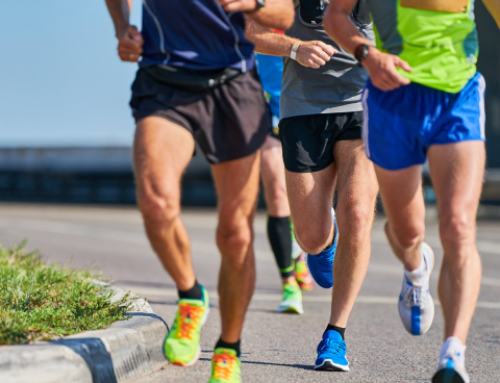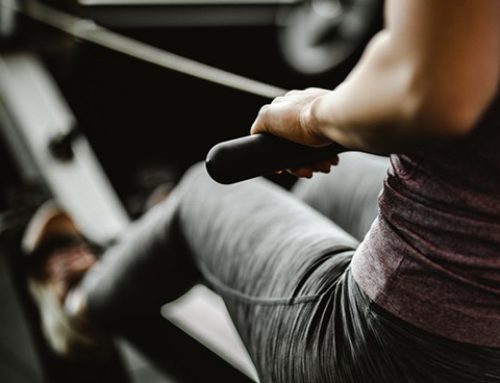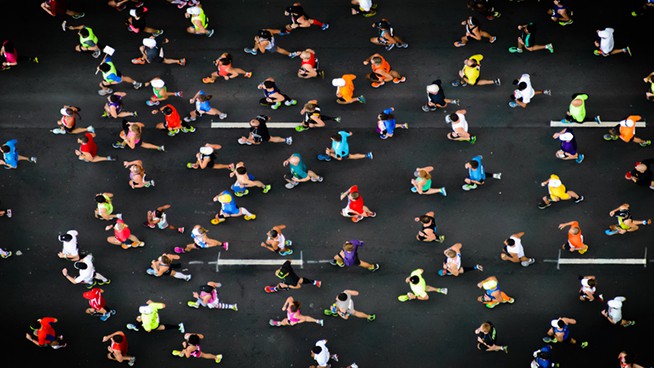Refine Your Sprinting Mechanics to Run a Faster Race
If you want to get faster, you can’t train aimlessly and do random numbers of sprints. To truly increase your speed, you must account for both the physiological and mechanical aspects of running. (See Perfect Running Form Checklist and Tips.)
The physiological aspect includes the amount of force you can put into the ground with each stride and how fast you can turn your leg over. However, if you lack the proper mechanics, you will fail to reach your top speed potential. (See Master Your Running Form.)
The body is a machine designed to move and work in specific patterns to produce effective movements. If you are struggling to get faster despite spending hours in the weight room, it’s time to refine your sprinting mechanics.
Sprinting Mechanics 101
Arm Action
Your arm angle should be at about 90 degrees. Remember, a longer lever is a slower lever. Your front hand should be at your chin and your back hand should be at your back pocket during each arm swing. Finally, keep your shoulders relaxed and your hands open to relieve muscle tension.
Foot Strike
When making contact with the ground, keep foot in a toe-up position. This will decrease the amount of time your foot spends on the ground and reduce stress on your bones and joints. You will propel yourself forward faster and reduce the risk of sustaining an overuse injury, like a stress fracture.
Acceleration Phase
The acceleration phase is different from the running technique used when you sprint at top speed, because you are driving your legs backward into the ground instead of pulling yourself forward. It’s critical to master this aspect of running so you can get to top speed as quickly as possible.
- Lean at a 45-degree angle.
- Hold the lean for eight to 12 yards (slightly shorter or longer depending on your age and athleticism). The faster you rise up, the slower your rate of acceleration will be.
- Extend your hips to generate power. Think about performing a vertical jump. If you do not extend your hips, you won’t jump high.
- Drive yours knees forward while extending your hips. This will keep you from falling as you lean at a deep forward angle. When your hip is fully flexed, your knee should be under your chest and your foot under your hips.
- Maintain a positive shin angle (shin pointing forward). As you drive your knee up, your leg should be “tight” so your foot does not release away from your leg, causing you to reach forward and overstride. This causes a braking motion that will slow you down.
RECOMMENDED FOR YOU
MOST POPULAR
Refine Your Sprinting Mechanics to Run a Faster Race
If you want to get faster, you can’t train aimlessly and do random numbers of sprints. To truly increase your speed, you must account for both the physiological and mechanical aspects of running. (See Perfect Running Form Checklist and Tips.)
The physiological aspect includes the amount of force you can put into the ground with each stride and how fast you can turn your leg over. However, if you lack the proper mechanics, you will fail to reach your top speed potential. (See Master Your Running Form.)
The body is a machine designed to move and work in specific patterns to produce effective movements. If you are struggling to get faster despite spending hours in the weight room, it’s time to refine your sprinting mechanics.
Sprinting Mechanics 101
Arm Action
Your arm angle should be at about 90 degrees. Remember, a longer lever is a slower lever. Your front hand should be at your chin and your back hand should be at your back pocket during each arm swing. Finally, keep your shoulders relaxed and your hands open to relieve muscle tension.
Foot Strike
When making contact with the ground, keep foot in a toe-up position. This will decrease the amount of time your foot spends on the ground and reduce stress on your bones and joints. You will propel yourself forward faster and reduce the risk of sustaining an overuse injury, like a stress fracture.
Acceleration Phase
The acceleration phase is different from the running technique used when you sprint at top speed, because you are driving your legs backward into the ground instead of pulling yourself forward. It’s critical to master this aspect of running so you can get to top speed as quickly as possible.
- Lean at a 45-degree angle.
- Hold the lean for eight to 12 yards (slightly shorter or longer depending on your age and athleticism). The faster you rise up, the slower your rate of acceleration will be.
- Extend your hips to generate power. Think about performing a vertical jump. If you do not extend your hips, you won’t jump high.
- Drive yours knees forward while extending your hips. This will keep you from falling as you lean at a deep forward angle. When your hip is fully flexed, your knee should be under your chest and your foot under your hips.
- Maintain a positive shin angle (shin pointing forward). As you drive your knee up, your leg should be “tight” so your foot does not release away from your leg, causing you to reach forward and overstride. This causes a braking motion that will slow you down.











